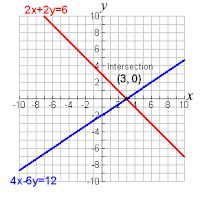Unit 5: Geometry and Construction
Day 1:
 |
An example of what a line of best fit
could look like |
- Objective: Students will use the line of best fit to find equations of lines.
- Make sure that your line of best fit represents the pattern of the data. It can go between a few points, just as long as it follows the majority of the data points (as shown at the left)
 |
Using the line of best fit to find the
equation |
Quiz time!!:
1.) Define a line of best fit.
2.) On graph paper, graph the following points and then draw
an appropriate line of best fit.
points: (1,12)(1,14)(2,10)(2,13)
(3,10)(3,12)(3,14)(4,7)(5,9)(5,11)(5,12)(7,5)(7,7)(7,10)(7,14)
(9,6)(9,8)(10,3)(11,5)(11,7)(12,3)(13,1)(14,2)(14,4)(14,6)(16,1)
(16,3)
3.) Write an equation for the line of best fit in #2.
Quiz Answers:
1.) The line of best fit is a line put through scattered data points
that represents the data. It can go through some points
but overall just represents the data points as a whole.
 Day 2:
Day 2:
- Objective: Students will write the linear equation of a line using data from a line of best fit, or given two points.
- Be sure to use the y=mx+b form when writing the equation. M is the slope, b is the y-intercept and x and y are the coordinate points. Also be sure to use y1-y2 over x2-x1 when finding the slope of the line.
 |
| How to find and use delta y and delta x |

Quiz!
1.) Find the equation of the line to the right. >>>
2.) State what the slope and y-intercept is in the equation above.
3.) Find the equation of a line passing through the points (2,2) and (8,6)
Quiz Answers:
- The equation of the line is y= 5/4x-3. I found this by calculating the slope using delta y over delta x and finding the y-intercept.
- The slope in the equation above is 5/4. This is the change in y over the change in x. (up five over four) The y intercept in the equation is -3. This is where the line crosses over the y-axis.
- Equation: y 2/3x+2/3 (work below)
For more on how to find the linear equation of a line from two points watch this video:
http://youtu.be/u9YZxBh1AxQ
Day 3:
- Objective: Students will define the y-intercept in math as well as translate it to a real world meaning.
- The y-intercept in math represents the y value (cost, time etc.) when x (months, days etc.) is zero. An example could be a company could charge you $5 for zero hours of work, and then $10 for one hour of work.
 Quiz!!
1.) State the y-intercept on the graph below
and explain what it means in the real world.
Quiz!!
1.) State the y-intercept on the graph below
and explain what it means in the real world.
2.) State the y-intercept on the graph below
and explain what it means in the real world.
3.) Explain why companies such as a cereal
company would charge you money for zero
ounces of cereal.
Quiz Answers
1.) The y-intercept is (0,50).
In the real world this means that
the carpet company is charging you
$50 for zero hours of work.
2.) The y-intercept is (0,6). In the real
world this means that the cereal
company is charging you $6 for zero
ounces of cereal.
3.) A cereal company would charge you
money for zero ounces of cereal so that
they can pay for manufacturing for the
cereal boxes. They also may just be
trying to make extra money.
For an example of the real life meaning of slope watch this video:
http://youtu.be/dKGiV0xwe_0
Day 4:

- Students will graph linear inequalities.
- When graphing linear equalities, you have to shade in the graph according to the equation. So if y is less, then you shade in below the line you graph. If it is greater, then you shade in above the line. When you see that it is also equal to, the line you graph needs to be solid. If it is not equal to, the line graphed needs to be a dotted line.

Quiz!!
1.) Graph the inequality: y>1/3x+6
2.) Graph the inequality: y<2x-6
3.) a.) Sally has at most 60 minutes to spend on homework and sports after school. List 5 combinations of ways Sally could spend her time.
b.) Graph the the time she could spend on each and write the equation. Use H to represent homework and S to represent sports.
- The shaded region represent what y could equal.
2. The shaded region also represents what y could equal.
Tips From the Pros Video: Email










































